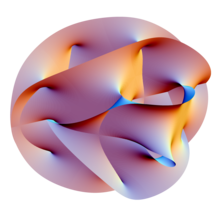Wikipedia:Picture peer review/Calabi-Yau manifold diagram
Calabi-Yau manifold[edit]

This image is displayed prominently in the geometry article, the Calabi–Yau manifold article, and the Fermat curve article. It is also used in the string theory article. I thought I might nominate it as a featured picture candidate because an alternate rendering was used on the cover of the November 2007 issue of Scientific American. (The image was originally misattributed, but a correction will be running in the March 2008 issue.) PS: the alternate rendering, Image:Calabi-Yau-alternate.png, hasn't been moved to Commons. Could I get some help with that, too? TIA, Lunch (talk) 06:22, 11 January 2008 (UTC)
- Comments
- Thanks for putting this up at PPR. I'm not too sure what to make of this; it is interesting, but perhaps needs some clarification. The first problem is that sadly neither image meets the size requirements, which say that it must be at least 1000px on at least one side. If this was in the svg format it would not be an issue, but these have been saved as png. I wonder if you have a bigger size or svg version?
You also say that the alternative was used on the cover of Sci Am, but the image description says it was created by you using Prof. Andrew Hanson's code - I guess what I'm getting at is whether this is the image that was used on Sci Am, or whether it's a replica version of an image that was on the cover? I'm also unclear on why your initial nom here is a different version than that used on Sci Am.
The easiest way to upload to commons is simply to navigate there (you can use this link), create an account if you don't have one (you can use the same user name as you have here), and then click the upload file link on the left (just as you would here). A template will open stepping you through the upload procedure. --jjron (talk) 11:36, 13 January 2008 (UTC) - Thanks for the comments.
Are people really that picky about the resolution limits? If so, I can regenerate the image, but it's a pain in the neck for a whopping whole of 100 pixels.
Regarding the two images, again, "Image:Calabi-Yau-alternate.png" was used on the cover of Scientific American. On the other hand, "Image:Calabi-Yau.png" is the version used in a number of Wikipedia articles. It seemed fitting to mention them both.
Regarding the "originality" of the images, I am the source of the images -- *not* Scientific American and *not* Andrew Hanson. No, I did not copy the image from the cover of Scientific American; they copied Wikipedia. Yes, I used a modified version of Andrew Hanson's code to generate the image. No, it is not his image. If Andrew Hanson took a photograph of the Empire State building, wrote a letter describing where he was standing and what time of day it was when he took the photo, mailed it to me, and I followed his directions, then we would produce two different images. He would have copyright in his, and I in mine. The same applies here. Whether or not you want to call this "creative" or "original" is another question as is whether or not this would disqualify the image from being a featured picture. Again, since Scientific American saw fit to copy Wikipedia's image, it seemed like a feather in the cap of Wikipedia, and it seemed fitting to try and highlight this.
Did I cover all my bases here? Does this make sense and seem like a good candidate?
- Yes, people really are picky about resolution requirements, and they are also fairly picky about format. I don't personally know how well .SVG does with gradients (can gradients be represented by vectors?), but, assuming that .SVG is the best format for this image, it would probably only get promoted as an .SVG version. With .SVG, resolution is irrelevant. - Enuja (talk) 20:27, 15 January 2008 (UTC)
- I understand that the image here is ‘’not’’ the exact version from Sci Am, but that image is also available – my question was why you’re nominating a different version here. If it’s simply that that is the version in the articles, then it’s easy enough to swap them over (having said which, I think I prefer the version you’ve put up here anyway, it’s just the other one may carry more weight on FPC if it was the actual Sci Am version).
- The analogy you draw is not quite correct. Essentially what I was saying was if you just used Andrew Hanson’s code then he it is really his image. It would be like you scanning his photograph and claiming it as your own (not like you following his instructions to take a similar image, as you say). If this is however substantially modified from his code, then you can possibly claim it as your own – I’m not sure ‘’how’’ modified it really needs to be, nor how modified it is. These things could become an issue on FPC, so please don’t get narky with me for asking them here.
- Re it’s chances on FPC, it’s hard to say (assuming you can get the bigger size or svg version if appropriate). Images like this sometimes do very well, sometimes get poleaxed. It’s pretty hard to tell in advance. The only way to really find out is to put it up there, explain yourself well, and see how it goes. --jjron (talk) 07:59, 20 January 2008 (UTC)
- Seconder
